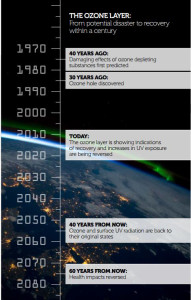The depletion of the ozone layer and the consequent increase in UV radiation at the surface of Earth has been an issue for over forty years. Over that period, there has been enormous progress in our understanding of the science behind ozone layer depletion and its recovery, the effects of ozone layer changes on surface UV radiation, and the consequences of changes in UV radiation on humans and the environment. Under the auspices of the Montreal Protocol, policy makers, industry, scientists and technologists have developed a collaborative process that has enabled a better understanding of the science, the environmental impacts, and the changes in technology that are necessary to safeguard society. This enables the Parties to the Protocol to balance the costs of action versus inaction, and assess the feasibility of coordinated societal, national and international action. Central to this process, the Montreal Protocol mandates regular independent updates on all these topics. Accordingly, the Scientific Assessment Panel (SAP), the Environmental Effects Assessment Panel (EEAP), and the Technology and Economic Assessment Panel (TEAP) have carried out major assessments at least every four years during the past three decades. Pages 5, 7 and 8 [of this Synthesis report] summarize major aspects of the ozone depletion issue and the Montreal Protocol.
This Synthesis Report presents the most recent, updated information and is particularly timely because: 1) Just over 40 years ago, Molina and Rowland’s landmark paper was published, which linked man-made chlorofluorocarbons with ozone layer depletion; 2) 30 years ago, the Antarctic ozone hole was discovered – it is the 20th century’s most dramatic manifestation of global environmental change; 3) 30 years ago, the Vienna Convention was adopted in 1985, and 2015 celebrates the thirtieth anniversary of this convention. This convention was followed soon after by the Montreal Protocol in 1987, providing the highly successful international framework to address the issue of ozone layer depletion. Given these momentous landmarks, it is appropriate not just to synthesize the most recent information but also to take into account the wider perspective of looking ahead and looking back over the last four decades, including developments in the science and
technology and in the regulatory actions during that period.
Read/Download the full Synthesis report

